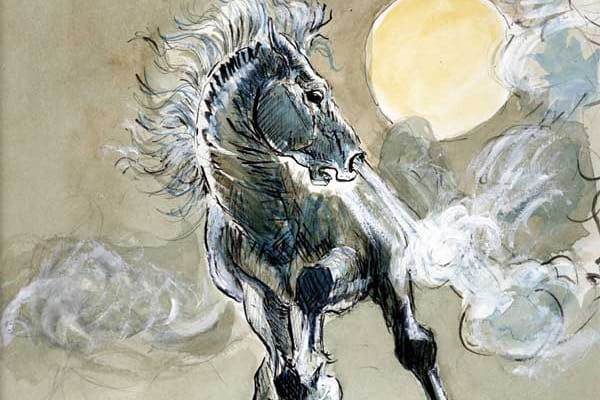What happens when a small, rural New Brunswick community becomes the backdrop for a best-selling novel?
The Nine Lives of Charlotte Taylor, featuring a village at the base of New Brunswick's Acadian Peninsula, hit bookstores in March 2007. Until then, the village existed quietly and contentedly amid its pastoral setting, but it suddenly became a point of interest on the literary map of Canada.
Sandwiched between the woods of northeastern New Brunswick and the waters of Miramichi Bay, Tabusintac has three churches, a convenience store, a community centre and a library/museum, housed in a building that dates from the early 20th century. At Old Home Week celebrations in 2000, souvenir T-shirts bore the inscription, "Where in heck is Tabusintac?"
So why would Sally Armstrong, a high-profile journalist and worldwide proponent of women's rights, choose the founder of such an unobtrusive little community as the subject for a novel?
The answer is simple. Armstrong, like most of Tabusintac's approximately 1,000 residents, can trace her roots back to her book's protagonist, Charlotte Taylor-frequently called "the mother of Tabusintac." In fact, Taylor is Armstrong's great, great, great grandmother. Loraine and Myles Wishart, Armstrong's aunt and uncle, live in the house where the original 1798 home of this remarkable female pioneer was built.

"I've been fascinated with Charlotte's story all my life…from the time my cousins and I sat on the floor in the kitchen listening to my grandparents, aunts and uncles telling stories about our matriarch," says Armstrong. "For as long as I can remember, I've tried to imagine the life she lived and how she ever survived it. In October 1995, I wrote my editorial column in Homemaker's Magazine about Charlotte… I heard from her descendents all over the world. That's when I decided I wanted to write the book, but my editors kept dispatching me to Bosnia and Somalia and Rwanda and Afghanistan. Finally in 2005 I took time off and settled down to tell her story."
Certainly Charlotte's real-life story furnished more than sufficient romance and adventure to fill a novel. In May 1775, pregnant by her father's black butler, the 20-year-old eloped with her lover from her home in Sussex, England. Together they travelled to the West Indies, where they planned to start a new life.
However ten days after the couple's arrival in Jamaica, Charlotte's partner died of yellow fever. Deciding the island wasn't the place for her, Charlotte managed passage north to the Youghall (Bathurst) area of Chaleur Bay. There, among the Mi'kmaq, she gave birth to a daughter she named Elizabeth.
Over the next 60 years she had three husbands, nine more children, and acquired considerable tracts of land. Eventually she settled permanently at Wishart's Point, named for her second husband, in Tabusintac.
"Not exactly a gentlewoman, although it was said she came from an aristocratic family in England," says Armstrong. "Nor was there much that seemed genteel about the settler sometimes referred to as 'that old Charlotte'.... But it was clear the family had a powerful respect for a woman long dead, as if their own fortitude and guile were family traits passed down from the ancestral matriarch."
Of course, Charlotte Taylor legends have been part of Tabusintac folklore for as long as anyone can remember. An American author was probably the first to write about her. In her 1965 novel called One Cubit, Alice Herrick Mumford refers to the young woman who came from England to live at "the Point." Probably not coincidentally, Mumford's husband had spent some time at Wishart Sporting Camp-also located at the Point.
The Sporting Life
The inconspicuous rural nature of the area played a major role in the success of the business begun by Charlotte's great grandson, a quarter century after her death. The unspoiled hinterland, comfortably remote from the bustle of town or city with its 12-mile frontage on the Tabusintac Lagoon, prompted John B. Wishart to begin an enterprise that would provide employment for many area residents, creating spin-offs affecting Tabusintac's future development for more than 100 years.
In the mid-1800s he began welcoming US sportspeople as paying guests into the home that had once belonged to Charlotte. Over the years wealthy Americans like the Rockefellers found the privacy they sought, combined with excellent hunting and fishing.
Country hospitality also played a major role in keeping people coming back year after year-for example guests were treated to excellent seaside country cuisine. Evening meals frequently began with oysters on the half shell, progressing to local lobster or salmon. Dessert might entail freshly baked blueberry or apple pie. And, of course, warm homemade bread was a staple at each meal.
While the women were busy preparing culinary delights for their visitors, local men were at work guiding them to the best hunting and fishing locations, and carving the hundreds of decoys necessary for successful waterfowl hunting. Some of these wooden lures captured the details of ducks and geese with a realism that made them decorative as well as functional.
In the late 1960s, plastic decoys began to replace the more cumbersome wooden ones, and most of the waterfowl carvers abandoned their work. Hundreds of hand-carved decoys were thrown into the oblivion of barns and sheds. Then, in the 1970s an American collector was passing through Tabusintac, and took as many as he could with him back to Maine. He later started the world-famous decoy auction house Guyette and Schmidt Inc.
Contemporary Charms
These days Tabusintac decoys carved by men such as Arch Morrison and Guy Robertson are valued folk art, fetching hundreds of dollars each at Guyette and Schmidt, now allied with Christies of New York. And while there aren't many of the traditional carvers left in Tabusintac, men like Lorne Stymiest still create decoys with pride. They're functional in rivers or marshes; however they're more likely to be found adorning homes and cottages.
Traditional hobbies are continued by Tabusintac women as well. Each Monday a group meets at the community centre to fashion quilts, one meticulous stitch after another. Good, hearty meals are also still part of the lifestyle-you won't find a lot of prepared foods or ready-to-go meals in the little community, but you can treat yourself to a hearty breakfast each Saturday morning at the country market in the community centre, and shop for crafts and baked goods.
"Originally the market was the brainchild of Annie Gay, who operates Annie's Country Store just across the road," says Gail Savoy, market manager. "A group of residents got together and her idea took off. We saw it as way to enhance community spirit, honour our traditions and attract visitors. And it's working. This self-sufficient project is staffed entirely by volunteers, and it's well into its third year."
Beyond quilting, carving and simple, local food, another Tabusintac tradition is storytelling. Folklore is kept alive and well by such proponents as 85-year-old Boucher Palmer. He tells the tale of the ghost of Mrs. Bundle, who haunts the section of the Hierlihy Road known as the Mill Hill, and of the phantom horse, sometimes seen at the same location, blowing steam from its nostrils.
Tales add to the charm of this rural place that has seen many changes, but has blended them into its fabric without spoiling the basic, laid-back, country ambience that is its essence. That's one reason why, in recent years, people looking for that ideal spot for a summer or retirement home have turned their gaze on Tabusintac.
Land Under My Feet
The indigenous Tabusintacers aren't just following traditions blindly-they appreciate the value and beauty of their small, rural community.
"I recall one of the Rockefellers offering my brother-in-law Eubulus McCallum a large sum for his farm," recalls 89-year-old Bertha Stymiest. "And do you know what he replied? He said, 'I'd rather have this land under my feet than your money in my pocket.'"
You certainly don't have to be from a place to love it. Julia Hierlihy, a native of Hamilton, Ont, has vacationed in Tabusintac more than 50 times since she married her husband, Glen-another descendent of Charlotte-in 1954. She still makes the annual pilgrimage, even though Glen died several years ago.
While hunting and fishing are no longer the attraction they once were, a nine-hole golf course with 16 adjacent chalets has recently been developed to attract visitors. At the Tabusintac River Bridge, a new marina for pleasurecraft has been built, allowing people to better enjoy the beauty of the river and its surroundings.
"The Nature Conservancy of Canada has labelled our community an ecological treasure," says Carmen Brynton, former director of the Miramichi Tourism Association. "We have so many unspoiled areas… we're relatively distant from any industrial polluters. We also have several bird sanctuaries as well as other projects in place, such as the Tabusintac Watershed Association, to protect our environment."
All this doesn't mean that community pride didn't balloon just a little when Sally Armstrong launched her book at the community's library/museum in March 2007. Suddenly, everyone with a relationship to Charlotte Taylor-and that meant most of the residents-was proudly declaring a connection to the redoubtable pioneer woman, ready to welcome visitors to the area that is the setting for The Nine Lives of Charlotte Taylor.
Will celebrity spoil Tabusintac? With rumours of a movie or TV mini-series based on Armstrong's book fluttering in the country breeze, it's a good question. However, since the little community has survived more than 200 years of innovation and change and yet managed to retain its pastoral character, there's reason to believe it will continue much as it has in the past.
According to legend, the name Tabusintac means "two names," "two entrances" or even "two rivers meeting," because it is situated where the Tabusintac River meets the Cove Brook to merge into Miramichi Bay. Perhaps its name will hold even more significance in the future, as the best of the past meets the best of the future and blends in harmony, like the two streams that merge happily on its doorstep.
An unofficial tour of Tabusintac
Since the publication of Sally Armstrong's novel The Nine Lives of Charlotte Taylor, friends who visit us in Tabusintac are eager to see the sites that play a role in this remarkable pioneer woman's story.
We begin the unofficial tour at our cottage situated on the Hierlihy Road, about a mile from Route ll. Charlotte's last husband was Philip Hierlihy, and this was part of their land grant. From there, we usually head for Wishart's Point to view the current house that was built on to Charlotte's original home. It's easy to envision the tall, red-headed woman standing on the Point looking out toward the bay and then upriver on a misty autumn day.
Two rivers meet in Charlotte's front yard, and you get a sense of the lonely yet prominent location she and her family chose to call home.
Then it's off upriver to see where Charlotte reputedly canoed in her senior years with her aboriginal companion of many years, Wioche. We trace the waterway Wioche would have taken to carry her body in his canoe to its final resting place, in Tabusintac's Riverview Cemetery, after she'd passed away at age 86.
We take the Old Manse Road and arrive at the cemetery to view the stone placed in her honour, naming her as the Mother of Tabusintac. (A caretaker recently mentioned that, since the book came out, there are three times as many out-of-town visitors to the cemetery to see the stone.)
Rounding out our tour, we stop in at the Country Market for a hearty breakfast and a chat. Just mention Charlotte's name and you're sure to hear a story.
